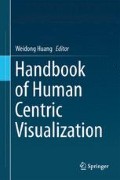Abstract
Graphic designers have excelled at conveying visual messages for decades. We take their work for granted: the back of a Wheaties box, an informative poster, a newspaper front page (Fig. 1), slides and web pages. One of graphic design’s primary goals is to create a “visual hierarchy” that gives structure to text and imagery, and improves viewer understanding. However, while graphic design methods have clearly been successful, there has been little work examining the reasons for that success, and few tools that help users apply those methods well. This is particularly surprising when we consider the ubiquity and indeed importance of this sort of visual communication in our lives. In this chapter, we lay the foundations for a research agenda that begins addressing these problems. We begin with a review of related research. In psychology, the Gestalt laws of visual grouping are clearly fundamental to the communication of knowledge structure, however little is known about how Gestalt laws work together to create complex hierarchies. Obviously design practice has a great deal to tell us, but the accepted theory of visual hierarchy is quite limited. We also examine pertinent research in human-computer interfaces and information visualization, especially of any related tools. We then propose a paradigm for studying the effective communication of complex visual structure, including possible measures of such effectiveness, and our own initial work along those lines. We conclude by discussing open questions in this line of research.
Access this chapter
Tax calculation will be finalised at checkout
Purchases are for personal use only
References
Bailey, R.: Human Performance engineering: A guide for system designers. Prentice-Hall (1982)
Ben-AV, M., Sagi, D.: Perceptual grouping by similarity and proximity: Experimental results can be predicted by intensity autocorrelations. Vision research 35, 853–866 (1995)
Bertin, J.: The Semiology of Graphics. University of Wisconsin Press (1983)
Grabinger, R.: Computer screen designs: viewer judgements. Educational Technology Research and Development 41(2), 35–73 (1993)
Han, S., Humphreys, G.: Relationship between uniform connectedness and proximity in perceptual grouping. Science in China Series C: Life Sciences 46, 113–126 (2003)
Han, S., Humphreys, G.W., Chen, L.: Uniform connectedness and classical Gestalt principles of perceptual grouping. Perception & Psychophysics 61, 661–674 (1999)
Jacobs, C., Li, W., Schrier, E., Bargeron, D., Salesin, D.: Adaptive Grid-Based Document Layout. In Proceedings of SIGGRAPH’03 pp. 838–847 (2003)
Jacobs, R.: What determines visual cue reliability? Trends in cognitive sciences 6, 345–350 (2002)
Kimchi, R.: Uniform connectedness and grouping in the perceptual organization of hierarchical patterns. J. Exp. Psychol. Hum. Percept. Perform. 24, 1105–1118 (1998)
Koffa, K.: Principle of Gestalt Psychology. London, Routledge & Kegan Paul Ltd. (1935)
Lidwell, W., Holden, K., Butler, J.: Gestalt Theory (Uber Gestalttheorie): 39–59, [Ellis, W.D.(Ed.) (1938): A sourcebook of Gestalt psychology. London: Routledge & Kegan Paul (1924)
Lidwell, W., Holden, K., Butler, J.: Universal Principles of Design. Rockport Publishers (2003)
Lok, S., Feiner, S.: A Survey of Automated Layout Techniques for Information Presentations. In Proceedings of SmartGraphics 2001 (2001)
Lok, S., Feiner, S., Ngai, G.: Evaluation of Visual Balance for Automated Layout. Proceedings of the 9th international conference on Intelligent user interface pp. 101–106 (2004)
Mayer, R.: Multimedia Learning. Cambridge University Press (2001)
Medin, D.L., Ross, N., Atran, S., et al.: Folkbiology of freshwater fish. Cognition 99, 237–273 (2006)
Ngo, D., Teo, L., Byrne, J.: Evaluating Interface Esthetics. Knowledge and Information Systems 4(1), 46–79 (2002)
Palmer, S.: Common region: A new principle of perceptual grouping. Cognitive Psychology 24, 436–447 (1992)
Palmer, S., Beck, D.: The repetition discrimination task: An objective method for studying perceptual grouping. Perception and Psychophysics 69(1), 68–78 (2007)
Palmer, S., Rock, I.: Rethinking perceptual organization: The role of uniform connectedness. Psychonomic bulletin & review 1(1), 29–55 (1994)
Parush, A., Nadir, R., Shtub, A.: Evaluating the layout of graphical user interface screens: Validation of a numerical, computerized model. International Journal of Human Computer Interaction 10(4), 343–360 (1998)
Rao, A., Lohse, G.: Towards a Texture Naming System: Identifying Relevant Dimensions of Texture. Vision Research 36(11), 1649–1669 (1996)
Roelfsema, P., Houtkamp, R.: Incremental grouping of image elements in vision. Attention, Perception, & Psychophysics 73(8), 2542–2572 (2011)
Romney, A., Weller, S., Batchelder, W.: Culture as consensus: a theory of culture and informant accuracy. Am. Anthropol. 88, 313–338 (1986)
Rosenholtz, R., Dorai, A., Freeman, R.: Do Predictions of Visual Perception Aid Design? ACM Transactions on Applied Perception 8(2) (2011)
Rosenholtz, R., Twarog, N.R., Schinkel-Bielefeld, N., Wattenberg, M.: An intuitive model of perceptual grouping for HCI design. In Proceedings of SIGCHI 2009 pp. 1331–1340 (2009)
Treisman, A.: Perceptual grouping and attention in visual search for features and for objects. Journal of Experimental Psychology: Human Perception and Performance 8(2), 194–214 (1982)
Tufte, E.R.: The cognitive style of PowerPoint, vol. 2006. Graphics Press Cheshire, CT (2003)
Tullis, T.: The Formatting of Alphanumeric Displays: A Review and Analysis. Human Factors 25(6), 657–682 (1983)
Tullis, T.: A system for evaluating screen formats: Research and application. Advances in human-computer interaction 2, 214–286 (1988)
Ware, C.: Visual thinking for design. Morgan Kaufmann (2008)
Wattenberg, M., Fisher, D.: A model of multi-scale perceptual organization in information graphics. Infovis 2003 (2003)
Williams, R.: The Non-Designer’s Design Book. Peachpit Press (2004)
Zhang, K., D., S.: Simple fast algorithms for the editing distance between trees and related problems. SIAM Journal of Computing 18, 1245–1262 (1989)
Author information
Authors and Affiliations
Corresponding author
Editor information
Editors and Affiliations
Rights and permissions
Copyright information
© 2014 Springer Science+Business Media New York
About this chapter
Cite this chapter
Bae, J., Watson, B. (2014). Toward a Better Understanding and Application of the Principles of Visual Communication. In: Huang, W. (eds) Handbook of Human Centric Visualization. Springer, New York, NY. https://doi.org/10.1007/978-1-4614-7485-2_7
Download citation
DOI: https://doi.org/10.1007/978-1-4614-7485-2_7
Published:
Publisher Name: Springer, New York, NY
Print ISBN: 978-1-4614-7484-5
Online ISBN: 978-1-4614-7485-2
eBook Packages: Computer ScienceComputer Science (R0)

